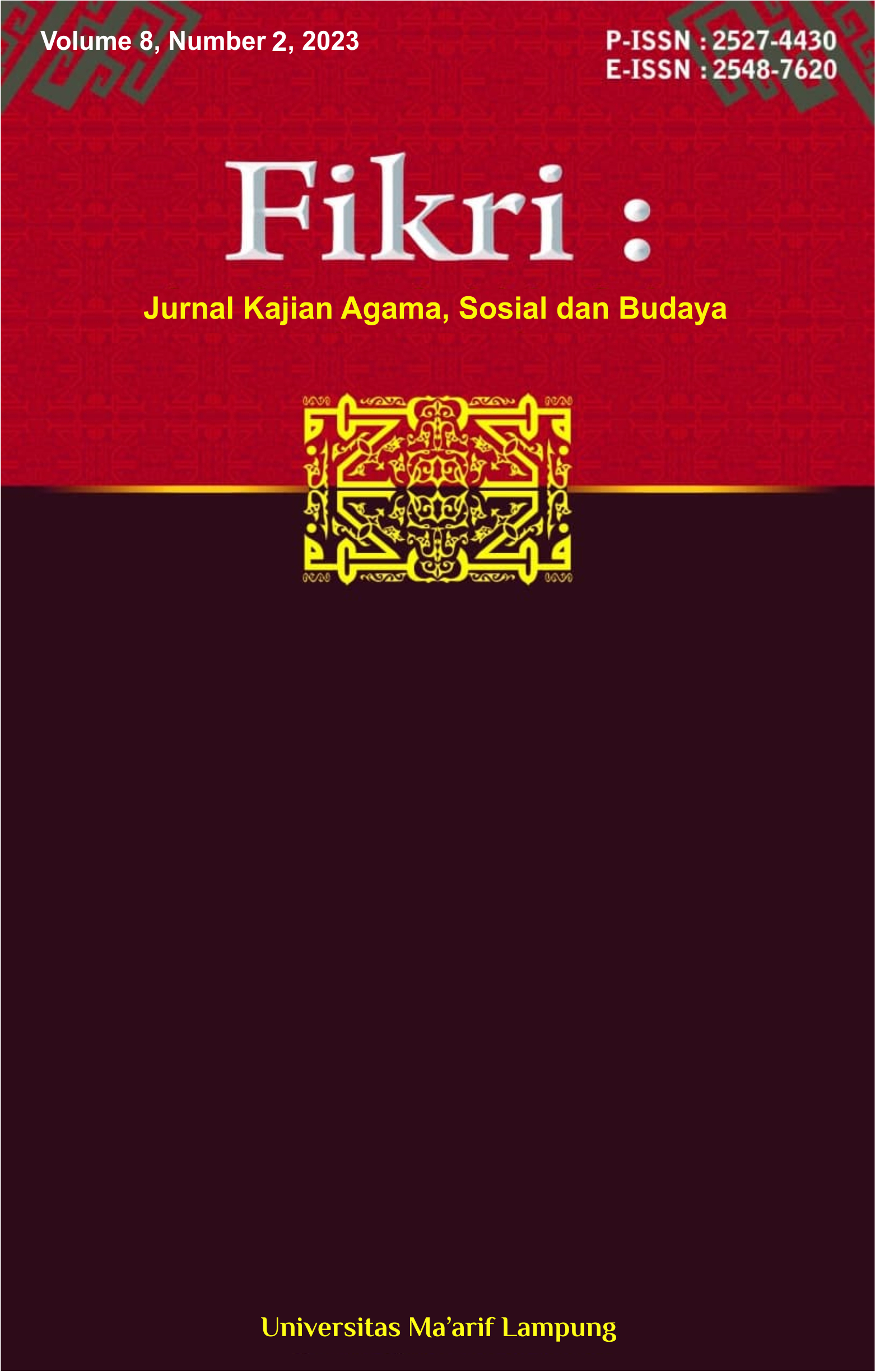“No Hijab in Workplace”: Discrimination against Muslim Women Employees in Indonesian Property Companies
DOI:
https://doi.org/10.25217/jf.v8i2.4046Keywords:
Discrimination, Employees, Hijab, Muslim WomenAbstract
The challenges of injustice faced by Muslim Women Employees who wear the hijab in the workplace still occur and have an impact on undeveloped career paths and low-paying job positions. Certain job positions do not require Muslim Women to wear the hijab, and some companies ask Muslim women who wear the hijab to take off their hijab. This research aimed to explore the challenges experienced by Muslim Women Employees who wear the hijab in their career paths and job positions at three property sector companies in Tangerang, Bekasi, and Semarang. The research was conducted using a qualitative phenomenological study method, and there were four informants from property companies in the Bekasi area, three people from property companies in the Tangerang area, and three from property companies in the Semarang area. The results of this study show that the forms of challenges experienced by the informants impacted their performance. Thus, the informants chose to resign from their jobs, and only one informant changed divisions. The study results also show that Muslim Women Employees who wear the hijab experience career stagnation due to non-objective assessments by superiors who do not like the way their hijab.
References
Chevillotte, E., & Dondé, C. (2023). Peer workers to address discrimination against women in psychiatry and mental health. L’Encéphale. https://doi.org/https://doi.org/10.1016/j.encep.2023.05.002
Ferrant, G., & Tuccio, M. (2015). South–South Migration and Discrimination Against Women in Social Institutions: A Two-way Relationship. World Development, 72, 240–254. https://doi.org/https://doi.org/10.1016/j.worlddev.2015.03.002
Garcia-Yeste, C., de Botton, L., Alvarez, P., & Campdepadros, R. (2021). Actions to promote the employment and social inclusion of muslim women who wear the hijab in catalonia (Spain). Sustainability (Switzerland), 13(13), 1–25. https://doi.org/10.3390/su13136991
Gatzweiler, F. W., Baumüller, H., Ladenburger, C., & Braun, J. von. (2011). Marginality: Addressing the Root Causes of Extreme Poverty (Germany (ed.); Issue April). University of Bonn. Google
Ghumman, S., & Ryan, A. M. (2013). Not welcome here: Discrimination towards women who wear the Muslim headscarf. Human Relations, 66(5), 671–698. https://doi.org/10.1177/0018726712469540
Hakim, A. R. (2022). Interpretative Phenomenological Analysis Tentang Konflik Kerja Wanita Berjilbab Dalam Menghadapi Diskriminasi. Psikologi Prima, 5(1), 1–9. https://doi.org/10.34012/psychoprima.v5i1.2755
Hoobler, J., Lemmon, G., & Wayne, S. (2011). Women’s underrepresentation in upper management: New insights on a persistent problem. Organizational Dynamics, 40, 151–156. https://doi.org/10.1016/j.orgdyn.2011.04.001
Karahan, H., & Tugsuz, N. (2021). The silent discrimination against headscarved professionals in the turkish labor market: The case of women in the banking sector. Sustainability (Switzerland), 13(20), 1–15. https://doi.org/10.3390/su132011324
Koura, F. (2018). Navigating islam: The hijab and the american workplace. Societies, 8(4). https://doi.org/10.3390/soc8040125
La Kahija, Y. (2018). Penelitian fenomenologis : Jalan memahami pengalaman hidup. Kanisius. Google
Magdalena, R. (2017). Kedudukan Perempuan dalam Perjalanan Sejarah (Studi tentang Kedudukan Perempuan dalam Masyarakat Islam). Harkat An-Nisa: Jurnal Studi Gender Dan Anak, 2(1), h. 22 26-27. https://e-journal.lp2m.uinjambi.ac.id/ojp/index.php/an-Nisa/article/view/116
Mas’ud, F. (2008). Menggugat Manajemen (Barat). Badan Penerbit Universitas Diponegoro. Google
Mavin, S. (2000). Approaches to careers in management: why UK organisations should consider gender. Career Development International, 5(1), 13–20. https://doi.org/10.1108/13620430010309323
Morrison, A., & Glinow, M. A. Von. (1990). Women and minorities in management. American Psychologist, 45, 200–208. https://doi.org/10.1037/0003-066X.45.2.200
Prastiwi, L. I. R., & Rahmadanik, D. (2020). Polemik dalam karir perempuan Indonesia. Jurnal Komunikasi Dan Kajian Media , 4(1), 1` – 11. http://dx.doi.org/10.31002/jkkm.v4i1.2375
Robbins, S. P., & Judge, T. A. (2017). Organizational behavior 17th ed. Harlow Pearson Education. Google
Sidik, M., Karim, A., Rahman, A., Pandangan, S. S., Persfektif, H., Syariati, A., Syahadah, ) ", & Pandangan, S. (2023). Al-Afkar: Journal for Islamic Studies Syahadah Sebagai Pandangan Hidup Persfektif Ali Syariati. Journal For Islamic Studies, 6(1), 327–337. https://doi.org/10.31943/afkarjournal.v6i1.472.
Solihatin, I. (2017). Konsepsi Al-Quran Tentang Perempuan Pekerja Dalam Mensejahterakan Keluarga. HARKAT: Media Komunikasi Islam Tentang Gender Dan Anak, 12(2), 38–48. https://doi.org/10.15408/harkat.v13i1.7714
Sugiyono. (2018). Metode Penelitian Pendidikan (Pendekatan Kuantitatif, Kualitatif, dan R&D). Alfabeta. Google
Tariq, M., & Syed, J. (2018). An intersectional perspective on Muslim women’s issues and experiences in employment. Gender, Work & Organization, 25(5), 495–513. https://doi.org/https://doi.org/10.1111/gwao.12256
Temizkan, R., & Uslu, A. N. (2023). The number of women in the cooking profession is low: Is it just because of gender discrimination? International Journal of Gastronomy and Food Science, 32, 100711. https://doi.org/https://doi.org/10.1016/j.ijgfs.2023.100711
Theodorson, G. A., & Theodorson, A. G. (1979). A modern dictionary of sociology. In TA - TT - (Repr). Barnes & Noble Books New York. https://doi.org/ LK - https://worldcat.org/title/185448285
Townsend, B. (1997). Breaking Through: The Glass Ceiling Revisited. Equal Opportunities International, 16(5), 4–13. https://doi.org/10.1108/eb010692
Tufyal Choudhury, & Fenwick, H. (2016). The Impact of Prevent on Muslim Communities. Equality and Human Rights Commission Research Report series. Google
Unsriana, L. (2014). Diskriminasi Gender dalam Novel Ginko Karya Junichi Watanabe. Lingua Cultura, 8(1), 40. https://doi.org/10.21512/lc.v8i1.441
Wallace, M., Wright, B., & Hyde, A. (2014). Religious Affiliation and Hiring Discrimination in the American South: A Field Experiment. Social Currents, 1, 189–207. https://doi.org/10.1177/2329496514524541
Weyer, B. (2007). Twenty years later: explaining the persistence of the glass ceiling for women leaders. Women in Management Review, 22(6), 482–496. https://doi.org/10.1108/09649420710778718
Downloads
Published
How to Cite
Issue
Section
License
Copyright (c) 2023 Siti Nur Fitasari, Fuad Mas’ud

This work is licensed under a Creative Commons Attribution-ShareAlike 4.0 International License.
Authors who publish with this journal agree to the following terms:
- Authors retain copyright and grant the journal right of first publication with the work simultaneously licensed under a Creative Commons Attribution License that allows others to share the work with an acknowledgement of the work's authorship and initial publication in this journal.
- Authors are able to enter into separate, additional contractual arrangements for the non-exclusive distribution of the journal's published version of the work (e.g., post it to an institutional repository or publish it in a book), with an acknowledgement of its initial publication in this journal.
- Authors are permitted and encouraged to post their work online (e.g., in institutional repositories or on their website) prior to and during the submission process, as it can lead to productive exchanges, as well as earlier and greater citation of published work.






